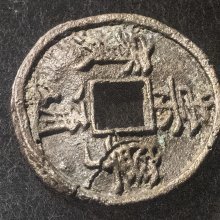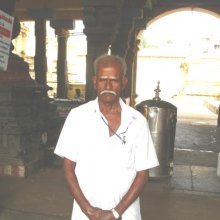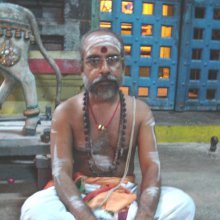Kashi, Kāśī, Kāsī, Kasi, Kāśi, Kāsi, Kaṣi, Kasī: 44 definitions
Introduction:
Kashi means something in Buddhism, Pali, Hinduism, Sanskrit, Jainism, Prakrit, the history of ancient India, Marathi, biology. If you want to know the exact meaning, history, etymology or English translation of this term then check out the descriptions on this page. Add your comment or reference to a book if you want to contribute to this summary article.
The Sanskrit terms Kāśī and Kāśi and Kaṣi can be transliterated into English as Kasi or Kashi, using the IAST transliteration scheme (?).
Images (photo gallery)
In Hinduism
Purana and Itihasa (epic history)
Source: Wisdom Library: Bhagavata PuranaKāśi (काशि):—Son of Kaśya (son of Suhotra). He had a son called Rāṣṭra. (see Bhāgavata Purāṇa 9.17.4)
Source: Wisdom Library: Skanda-puranaKāśī (काशी), or Vārāṇasī, is described as a fascinating city which is beyond the range of vision of Giriśa (Śiva), according to the Skandapurāṇa 4.2.53. It is a place where yoginīs become ayoginīs, after having come in contact with it. Kāśī is described as having both the power to destroy great delusion, as well as creating it.
Accordingly, “the whole universe is deluded by the Māyā of Viṣṇu. Indeed, this Kāśī is the personified form thereof. It is the sole enchanter of the universe. Setting aside brothers, wives, son, land, house andwealth, even facing death, all resort to Kāśī.”
The Skandapurāṇa narrates the details and legends surrounding numerous holy pilgrimages (tīrtha-māhātmya) throughout India. It is the largest Mahāpurāṇa composed of over 81,000 metrical verses, with the core text dating from the before the 4th-century CE.
Source: archive.org: Personal and geographical names in the Gupta inscriptions (purana)Kāśī (काशी).—The Skandapurāṇa says that the city of Kāśī became famous by that name because it sheds light on (the way to) nirvāṇa or because, that indescribable refulgence, viz. god Śiva shines forth here. Kāśī has been a place of much improtance for Hindu pilgrimage. Its religious importance has been discussed at length in the Kāśīkhaṇḍa of the Skanda Purāṇa. Lord Śiva never leaves it, hence it is known as Avimukta. A man who dies here is believed to get emancipation.
Source: archive.org: Puranic Encyclopedia1) Kāśī (काशी).—(VĀRĀṆASĪ. BANARAS). (See under Divodāsa also). General. One of the oldest and most popular sacred centres in India, Kāśī is reputed for its Viśvanātha temple of hoary traditions, according to one of which the Śivaliṅga in the temple was installed by Brahmā himself. (Hālāsya Māhātmya). (See full article at Story of Kāśī from the Puranic encyclopaedia by Vettam Mani)
2) Kāśī (काशी).—An inhabitant-citizen-of Kāśī. (Bhīṣma Parva, Chapter 106, Verse 18).
3) Kāśī (काशी).—A son of Kaviprajāpati. (Anuśāsana Parva, Chapter 85, Verse 133).
Source: archive.org: Shiva Purana - English Translation1) Kāśī (काशी) refers to one of the seven sacred cities of the Hindus, according to a footnote at the Śivapurāṇa-māhātmya chapter 1. Accordingly, —“[...] the holy rivers, Gaṅgā and others, the seven sacred cities [viz., Kāśī] and Gayā can never be equal to Śivapurāṇa. If one wishes for the greatest of goals (Liberation) one shall recite at least a stanza or even half of it from Śivapurāṇa. He who constantly listens to Śivapurāṇa fully comprehending its meaning or simply reads it with devotion is undoubtedly a meritorious soul”.
The seven sacred cities of the Hindus are: Ayodhyā, Mathurā, Māyā, Kāśī, Kāñcī, Āvantikā and Dvārikā.
2) Kāśī (काशी) is the name of a ancient country/region from where the Rudrākṣa trees are said to be very sacred, according to the Śivapurāṇa 1.25, while explaining the greatness of Rudrākṣa:—“[...] Rudrākṣas grown in Gauḍa land became great favourites of Śiva. They were grown in Mathurā, Laṅkā, Ayodhyā, Malaya, Sahya mountain, Kāśī and other places. They are competent to break asunder the clustered sins unbearable to the others, as the sacred texts have declared”.
Source: Cologne Digital Sanskrit Dictionaries: The Purana Index1) Kāśi (काशि).—Son of Kāśya and father of Rāṣṭra.*
- * Bhāgavata-purāṇa IX. 17. 4.
2a) Kāśī (काशी).——(c)—a kingdom of Madhyadeśa;1 a tribe;2 a Janapada3 enlisted by Jarāsandha against the Yadus.4
- 1) Brahmāṇḍa-purāṇa II. 16. 41; 18. 51; III. 74. 213 and 268.
- 2) Matsya-purāṇa 114. 35; 163. 67; 273. 73.
- 3) Vāyu-purāṇa 45. 110; 47. 48.
- 4) Bhāgavata-purāṇa X. [50 (V) 3].
2b) The mother of Sarvaga (Sarvavṛka, Vāyu-purāṇa) by Bhīmasena.*
- * Matsya-purāṇa 50. 54; Vāyu-purāṇa 99. 247; Viṣṇu-purāṇa IV. 20. 46.
3) Kāsī (कासी).—Capital of Pauṇḍraka invaded by Kṛṣṇa; Pauṇḍraka on the S. of the Gomanta hill during the siege by Jarāsandha.1 The abhicāra Agni sent by Sudakṣiṇa returned and killed Sudakṣiṇa himself, while Viṣṇu's Cakra burnt down the whole city.2 Its king went to Syamantapañcaka for solar eclipse having heard that Kṛṣṇa was there.3 When the kingdom had no rains, its king gave his daughter Gāndinī to Śvaphalka, and this resulted in plenty of showers.4 Likened to bhāgavata purāṇa in its importance.5 Sages of, visited Dvārakā.6 Residence of Kāmākṣī7 the capital of Kuśadhvaja;8 in the brows of the Veda.9
- 1) Bhāgavata-purāṇa X. 66. [12], 10; 52. 11 [9].
- 2) Ib. X. 66. 30-42; 37. 19.
- 3) Ib. X. 82. 25.
- 4) Ib. X. 57. 32. Brahmāṇḍa-purāṇa III. 71. 104.
- 5) Bhāgavata-purāṇa XII. 13. 17.
- 6) Ib. X. 90. 28 [3].
- 7) Brahmāṇḍa-purāṇa IV. 37. 15; 40. 15 and 80, 91.
- 8) Vāyu-purāṇa 81. 18; 99. 402.
- 9) Ib. 104. 75.
Kāśi (काशि) is a name mentioned in the Mahābhārata (cf. II.27.6, VI.10.38, VI.52.13, VI.112.73) and represents one of the many proper names used for people and places. Note: The Mahābhārata (mentioning Kāśi) is a Sanskrit epic poem consisting of 100,000 ślokas (metrical verses) and is over 2000 years old.

The Purana (पुराण, purāṇas) refers to Sanskrit literature preserving ancient India’s vast cultural history, including historical legends, religious ceremonies, various arts and sciences. The eighteen mahapuranas total over 400,000 shlokas (metrical couplets) and date to at least several centuries BCE.
Vaishnavism (Vaishava dharma)
Source: ISKCON Press: GlossaryKāśī (काशी).—One of the oldest sacred places of learning in India. The Purāṇic name of the modern city of Benares in the North Indian state of Uttar Pradesh. It is the place of Lord Śiva and generally the followers of Lord Śiva live there. Ambā, Ambikā and Ambālikā were abducted by Bhīṣma from this city.
Source: Pure Bhakti: Brhad BhagavatamrtamKāśī (काशी) refers to:—The city of Vārāṇasī, or Benares in Uttar Pradesh located on the banks of the River Gaṅgā; a city sacred to Śrī Śiva and famous as a place of learning. (cf. Glossary page from Śrī Bṛhad-bhāgavatāmṛta).

Vaishnava (वैष्णव, vaiṣṇava) or vaishnavism (vaiṣṇavism) represents a tradition of Hinduism worshipping Vishnu as the supreme Lord. Similar to the Shaktism and Shaivism traditions, Vaishnavism also developed as an individual movement, famous for its exposition of the dashavatara (‘ten avatars of Vishnu’).
Natyashastra (theatrics and dramaturgy)
Source: Wisdom Library: Nāṭya-śāstraKāśi (काशि) is the name of a tribe, usually to be represented by a brown (asita) color when painting the limbs (aṅgaracanā), according to Nāṭyaśāstra chapter 23. The painting is a component of nepathya (costumes and make-up) and is to be done in accordance with the science of āhāryābhinaya (extraneous representation).

Natyashastra (नाट्यशास्त्र, nāṭyaśāstra) refers to both the ancient Indian tradition (shastra) of performing arts, (natya—theatrics, drama, dance, music), as well as the name of a Sanskrit work dealing with these subjects. It also teaches the rules for composing Dramatic plays (nataka), construction and performance of Theater, and Poetic works (kavya).
Kavya (poetry)
Source: Wisdom Library: KathāsaritsāgaraKāśī (काशी) is the name of a kingdom that was conquered by Udayana (king of Vatsa) during his campaign to obtain sovereignty over the whole earth, according to the Kathāsaritsāgara, chapter 19. Accordingly, “When he heard of that, Brahmadatta (King of Benares, Kāśī), having found all his stratagems fail, came to the conclusion that the King of Vatsa, who filled with his forces the whole country, was hard to overcome. After deliberating and sending an ambassador, he came in person to the King of Vatsa, who was encamped near, placing his clasped hands upon his head in token of submission”.
The Kathāsaritsāgara (‘ocean of streams of story’), mentioning Kāśī, is a famous Sanskrit epic story revolving around prince Naravāhanadatta and his quest to become the emperor of the vidyādharas (celestial beings). The work is said to have been an adaptation of Guṇāḍhya’s Bṛhatkathā consisting of 100,000 verses, which in turn is part of a larger work containing 700,000 verses.
Source: archive.org: Aspects of Bengal society: Ship-building and commerceKasi is the name of an ancient city mentioned by the author of the Kavikankan’s Chandikāvya pp. 195-202.—Accordingly, after the performance of the usual ceremonies before sailing, the merchant Dhanapati passed the following places: [...]—all by the side of the Ganges. Then he reached the very celebrated inland port of Bengal known as Saptagram near the Tribeni. The poet here incidentally praised this port and gave it a superiour place among the following ports and places: [e.g., Kasi, etc...]. According to the poet the merchants of the above places visit Saptagram but the merchants of Saptagram do never visit those ports and places.

Kavya (काव्य, kavya) refers to Sanskrit poetry, a popular ancient Indian tradition of literature. There have been many Sanskrit poets over the ages, hailing from ancient India and beyond. This topic includes mahakavya, or ‘epic poetry’ and natya, or ‘dramatic poetry’.
Shaivism (Shaiva philosophy)
Source: archive.org: Personal and geographical names in the Gupta inscriptions (shaivism)Kāśī (काशी).—During the period of Gupta rule Kāśī was on its way to become a strong centre of Śiva worship with the mahāliṅgas set up in different parts of the city.

Shaiva (शैव, śaiva) or Shaivism (śaivism) represents a tradition of Hinduism worshiping Shiva as the supreme being. Closely related to Shaktism, Shaiva literature includes a range of scriptures, including Tantras, while the root of this tradition may be traced back to the ancient Vedas.
Nirukta (Sanskrit etymology)
Source: Shodhganga: The saurapurana - a critical study (nirukta)Kāśī (काशी) is another name for Vārāṇasī.—Kāśī is derived from the root kāś “to shine”. Skandapurāṇa IV.26.67 states that the city of Kāśī is famous by that name because it sheds light, that is the Lord Śiva shines forth there.
Nirukta (निरुक्त) or “etymology” refers to the linguistic analysis of the Sanskrit language. This branch studies the interpretation of common and ancient words and explains them in their proper context. Nirukta is one of the six additional sciences (vedanga) to be studied along with the Vedas.
Jyotisha (astronomy and astrology)
Source: Wisdom Library: Brihat Samhita by VarahamihiraKāśī (काशी) refers to a country identified with Benares, belonging to “Pūrvā or Pūrvadeśa (eastern division)” classified under the constellations of Ārdrā, Punarvasu and Puṣya, according to the system of Kūrmavibhāga, according to the Bṛhatsaṃhitā (chapter 14), an encyclopedic Sanskrit work written by Varāhamihira mainly focusing on the science of ancient Indian astronomy astronomy (Jyotiṣa).—Accordingly, “The countries of the Earth beginning from the centre of Bhāratavarṣa and going round the east, south-east, south, etc., are divided into 9 divisions corresponding to the 27 lunar asterisms at the rate of 3 for each division and beginning from Kṛttikā. The constellations of Ārdrā, Punarvasu and Puṣya represent the eastern division consisting of [i.e., Kāśī] [...]”.

Jyotisha (ज्योतिष, jyotiṣa or jyotish) refers to ‘astronomy’ or “Vedic astrology” and represents the fifth of the six Vedangas (additional sciences to be studied along with the Vedas). Jyotisha concerns itself with the study and prediction of the movements of celestial bodies, in order to calculate the auspicious time for rituals and ceremonies.
In Buddhism
Theravada (major branch of Buddhism)
Source: Pali Kanon: Pali Proper Names1. Kāsi (Kāsika) - One of the sixteen Mahajanapadas (A.i.213, etc.), its capital being Baranasi.
At the time of the Buddha, it had been absorbed into the kingdom of Kosala, and Pasenadi was king of both countries (D.i.288; M.ii.111). The Mahavagga (Vin.i.28l), however, mentions a Kasika raja (king of Kasi?) who sent a robe to Jivaka. Buddhaghosa (see Vinaya Texts ii.195, n.2) says that this was a brother of Pasenadi and son of the same father. He was probably a sub king of Pasenadi. Pasenadis father, Mahakosala, on giving his daughter in marriage to Bimbisara, allotted her a village of Kasi (Kasigama, q.v.) as bath money (J.iv.342; J.ii.403; SA.i.110,120f, etc.). Even at this time, however, the memory of Kasi as an independent kingdom seems to have been still fresh in mens minds. It is very frequently mentioned as such in the Jatakas and elsewhere. Kasi was once ruled by the Bharatas, one of whom, Dhatarattha, was its king in the time of Renu (D.ii.235f). There seem to have been frequent wars between the countries of Kasi and Kosala, victory belonging now to one, now to the other. In one such war, Dighati (q.v.), the Kosala king, was defeated by the king of Kasi, but Dighitis son Dighavu won back the kingdom (Vin.i.334; J.iii.487; DhA.i.46). In another war the Kasi king, Mahasilava, was taken captive by the ruler of Kosala, but his kingdom was later restored to him (J.i.262, etc.; see also i.409; UdA.123).
The traditional name of the king of Kasi from time immemorial was evidently Brahmadatta (q.v.), and references to kings of that name abound in the Jatakas. Sometimes the king is referred to merely as Kasi raja. Among other kings of Kasi mentioned are Kiki (M.ii.49) and Kalabu (J.iii.39). The extent of the Kasi kingdom is given as three hundred leagues (J.v.41; also iii.304, 391).
The capital of Kasi is generally given as Baranasi, but it is said that when Asoka was king of Kasi his capital was in Potali (J.iii.155), and another king, Udaya bhadda, had his seat of government in Surundha (J.iv.104ff). It is possible that these cities did not form part of the regular kingdom of Kasi, but became annexed to it during the reigns of some of the more powerful kings.
Kasi was evidently a great centre of trade and a most populous and prosperous country. Frequent mention is made of caravans leaving Kasi to travel for trade. One highway went through Kasi to Rajagaha (Vin.i.212) and another to Savatthi (Vin.ii.10; Mhv.v.114). Kasi was famed for her silks, and Kasi robes were most highly esteemed as gifts, each robe being valued at one hundred thousand. (See, e.g., J.vi.151, 450;
2. Kāsi, or Kāsika.- A city, the birthplace of Phussa Buddha (Bu.xix.14; J.i.41). There he taught the Buddhavaṃsa (BuA.193). The city is probably to be identified with Benares, which is sometimes referred to as Kāsipura (e.g., DhA.i.71; J.v.54; vi.165; M.i.171; DhsA.35; Cv.xli.37). It is also called Kāsipurī (PvA.19).
Theravāda is a major branch of Buddhism having the the Pali canon (tipitaka) as their canonical literature, which includes the vinaya-pitaka (monastic rules), the sutta-pitaka (Buddhist sermons) and the abhidhamma-pitaka (philosophy and psychology).
Mahayana (major branch of Buddhism)
Source: archive.org: Bulletin of the French School of the Far East (volume 5)Kāśī (काशी) (in Chinese: Kia-che) is the name of an ancient kingdom associated with Mṛgaśiras or Mṛgaśirasnakṣatra, as mentioned in chapter 18 of the Candragarbha: the 55th section of the Mahāsaṃnipāta-sūtra, a large compilation of Sūtras (texts) in Mahāyāna Buddhism partly available in Sanskrit, Tibetan and Chinese.—Chapter 18 deals with geographical astrology and, in conversation with Brahmarāja and others, Buddha explains how he entrusts the Nakṣatras [e.g., Mṛgaśiras] with a group of kingdoms [e.g., Kāś] for the sake of protection and prosperity.
Source: Kunpal: Shantideva's Bodhisattva-charyavataraKāśi is the old name for Benares (Vārāṇasī).

Mahayana (महायान, mahāyāna) is a major branch of Buddhism focusing on the path of a Bodhisattva (spiritual aspirants/ enlightened beings). Extant literature is vast and primarely composed in the Sanskrit language. There are many sūtras of which some of the earliest are the various Prajñāpāramitā sūtras.
General definition (in Buddhism)
Source: archive.org: Personal and geographical names in the Gupta inscriptions (buddhism)Kāśī (काशी).—At the time of Buddha, the kingdom of Kāśī was absorbed by the kingdom of Kośala. We know that Lord Buddha gave his first discourse near Kāśī in the Deer Park at Sārnāth. Kāśī was an important Buddhist centre and was a seat of monastic establishments in the time of Aśoka.
In Jainism
General definition (in Jainism)
Source: archive.org: TrisastisalakapurusacaritraKāśi (काशि) (distinguished by the city Vārāṇasī) refers to one of the 25½ countries of the Kṣetrāryas, situated in the “middle world” (madhyaloka), according to chapter 2.3 [ajitanātha-caritra] of Hemacandra’s 11th century Triṣaṣṭiśalākāpuruṣacaritra (“lives of the 63 illustrious persons”): a Sanskrit epic poem narrating the history and legends of sixty-three important persons in Jainism.
Accordingly:—“In these 35 zones on this side of Mānuṣottara and in the Antaradvīpas, men arise by birth; [...]. From the division into Āryas and Mlecchas they are two-fold. The Āryas have sub-divisions [e.g., kṣetra (country)]. [...] The kṣetrāryas are born in the 15 Karmabhumis. Here in Bharata they have 25½ places of origin (e.g., Kāśi), distinguishable by cities (e.g., Vārāṇasī) in which the birth of Tīrthakṛts, Cakrabhṛts, Kṛṣṇas, and Balas takes place”.

Jainism is an Indian religion of Dharma whose doctrine revolves around harmlessness (ahimsa) towards every living being. The two major branches (Digambara and Svetambara) of Jainism stimulate self-control (or, shramana, ‘self-reliance’) and spiritual development through a path of peace for the soul to progess to the ultimate goal.
India history and geography
Source: archive.org: Personal and geographical names in the Gupta inscriptionsKāśī (काशी) is a place-name without suffix and is mentioned in the Gupta inscription No. 28. The Gupta empire (r. 3rd-century CE), founded by Śrī Gupta, covered much of ancient India and embraced the Dharmic religions such as Hinduism, Buddhism and Jainism. The name Kāśī is derived from the root kaś ‘to shine’. It was a great centre of trade and commerce. Patañjali in his Mahābhāṣya mentions Kāśī cloth. The Buddhist literature gives us many accounts of the merchants of the city.
Kāśī has been known for centuries under five different names, viz., Vārāṇasī (modern Banaras), Kāśī, Avimukta, Ānandakānana and Śmaśāna or Mahāśmaśāna. Vārāṇasī was the capital of the people of Kāśī.584 Thus it seems that geographically Kāśī represented a larger area than Vārāṇasī, the latter being the capital of the former. But in medieval times the position became just the reverse. Vārāṇasī comprehended the entire district and Kāśī generally represented only a small place.
Source: archive.org: Shiva Purana (history)Kāśī (काशी) or Kāśikā, known as Vārāṇasī. Situated on the left bank of the Ganges, it was the capital of the country of the same name. It is, perhaps, the Kassida or Kassidia of Ptolemy, designated after Kāśīrāja, one of the early progenitors of the lunar race who was succeeded by twenty descendants, including the famous Divodāsa who ruled and celebrated many horse-sacrifices here. The city is sacred to Śiva since Viśveśvara, one of the twelve Jyotirliṅgas, is established here.
Source: Project Gutenberg: Castes and Tribes of Southern India, Volume 1Kasi (“benares”) refers to one of the gotras (clans) among the Medaras: workers in bamboo in the Telugu, Canarese, Oriya and Tamil countries. The Medara people believe that they came from Mahendrachala mountain, the mountain of Indra. They are also known as the Meda, Medarlu or Medarakaran.
Source: Ancient Buddhist Texts: Geography of Early BuddhismKāsī is one of the sixteen Mahājanapadas of the Majjhimadesa (Middle Country) of ancient India, as recorded in the Pāli Buddhist texts (detailing the geography of ancient India as it was known in to Early Buddhism).—In the Aṅguttara Nikāya Kāsī is included in the list of sixteen Mahājanapadas. Its capital was Bārāṇasī (mod. Benares) which had other names as well, viz. Surundhana, Sudassana, Brahmavaddhana, Pupphavatī, Ramma and Molinī. The extent of the city is mentioned as 12 yojanas whereas Mithilā and Indapatta were each only seven leagues in extent.
Before the time of the Buddha, Kāsī was a great political power. Its kings from time to time fought with the Kosalan kings. Sometimes Kāsī extended its suzerain power over Kosala and sometimes Kosala conquered Kāsī. But on the whole it appears that before the Buddha’s time Kāsī was the most powerful kingdom in the whole of northern India. But in the time of the Buddha, Kāsī lost its political power. It was incorporated sometime into the Kosalan kingdom and sometime into the Magadhan kingdom. There were fierce fights between Pasenadi, king of Kosala, and Ajātasattu, King of Magadha, regarding the possession of Kāsī. Kāsī was finally conquered and incorporated into the Magadha kingdom when Ajātasattu defeated the Kosalans and became the most powerful king of Northern India.
Source: Shodhganga: A translation of Jhaverchand Meghanis non translated folk talesKashi refers to “It is situated on the left side of the river Ganga. It is one of the main religious places of Hindu in Benares. As it is situated between the river Varuna and Ashi; it is also known as Varanasi. There is a belief that one get salvation if one dies in Kashi. There is a saying in Gujarati ‘Surat nu jaman ane kashi nu maran’-(Food of Surat and death in Kashi. In south Gujarat Surat is known for a variety and delicious cuisine)”.—It is defined in the glossary attached to the study dealing with Gujarat Folk tales composed by Gujarati poet Jhaverchand Meghani (1896-1947)

The history of India traces the identification of countries, villages, towns and other regions of India, as well as mythology, zoology, royal dynasties, rulers, tribes, local festivities and traditions and regional languages. Ancient India enjoyed religious freedom and encourages the path of Dharma, a concept common to Buddhism, Hinduism, and Jainism.
Biology (plants and animals)
Source: Wisdom Library: Local Names of Plants and DrugsKasi in the Gujarati language is the name of a plant identified with Coix lacryma-jobi from the Poaceae (Grass) family having the following synonyms: Coix arundinacea, Coix lachryma. For the possible medicinal usage of kasi, you can check this page for potential sources and references, although be aware that any some or none of the side-effects may not be mentioned here, wether they be harmful or beneficial to health.
Source: Google Books: CRC World Dictionary (Regional names)Kasi in Indonesia is the name of a plant defined with Carica papaya in various botanical sources. This page contains potential references in Ayurveda, modern medicine, and other folk traditions or local practices It has the synonym Vasconcellea peltata A. DC. (among others).
Example references for further research on medicinal uses or toxicity (see latin names for full list):
· Florae Fluminensis Icones
· Flore des Antilles (1824)
· De Fructibus et Seminibus Plantarum (1790)
· Verhandelingen van het bataviaasch genootschap van kunsten en wetenschappen (1790)
· Eclogae Plantarum Rariorum (1811)
· Encyclopédie Méthodique, Botanique (Lamarck) (1804)
If you are looking for specific details regarding Kasi, for example diet and recipes, side effects, extract dosage, health benefits, pregnancy safety, chemical composition, have a look at these references.

This sections includes definitions from the five kingdoms of living things: Animals, Plants, Fungi, Protists and Monera. It will include both the official binomial nomenclature (scientific names usually in Latin) as well as regional spellings and variants.
Languages of India and abroad
Pali-English dictionary
Source: BuddhaSasana: Concise Pali-English Dictionarykasi : (aor. of kasati) ploughed; tilled. || kāsi (m.), name of a country (the capital of which was Benares).
Source: Sutta: The Pali Text Society's Pali-English DictionaryKasi, and Kasī (f.) (fr. kasāti) tilling, ploughing; agriculture, cultivation M. II, 198; S. I, 172, 173=Sn. 76 sq.; Vin. IV, 6; Pv. I, 56 (k°, gorakkha, vaṇijjā); PvA. 7; Sdhp. 390 (k°, vaṇijjā); VvA. 63.—°ṃ kasati to plough, to till the land J. I, 277; Vism. 284.
—kamma the act or occupation of ploughing, agriculture J. II, 165, 300; III, 270.—karaṇa ploughing, tilling of the field PvA. 66;—khetta a place for cultivation, a field PvA. 8 (kasī°);—gorakkha agriculture and cattle breeding D. I, 135;—bhaṇḍa ploughing implements DhA. I, 307. (Page 201)

Pali is the language of the Tipiṭaka, which is the sacred canon of Theravāda Buddhism and contains much of the Buddha’s speech. Closeley related to Sanskrit, both languages are used interchangeably between religions.
Marathi-English dictionary
Source: DDSA: The Molesworth Marathi and English Dictionarykaśī (कशी).—f C A thrashed or an empty head (esp. of nācaṇī). See piśī.
--- OR ---
kāśī (काशी).—f (S) A celebrated city and place of pilgrimage, Benares. 2 C A melon-plantation. kāśīrāmēśvarācēṃ antara (The interval or distance betwixt the two towns kāśī & rāmēśvara) Far as the poles asunder. kāśīcī vāṭa dākhaviṇēṃ To raise (a child &c.) by the ears, and rub the thumb forcibly along his crown; to show London. kāśīsa gēlā kāśīdāsa mathurēsa gēlā mathurādāsa Used of a timeserver or trimmer.
--- OR ---
kāśī (काशी) [or कांशी, kāṃśī].—f See this in the plural number (kāśā).
Source: DDSA: The Aryabhusan school dictionary, Marathi-Englishkāśī (काशी).—f Benares. kāśīphaḷa n A pompion, gourd.
Marathi is an Indo-European language having over 70 million native speakers people in (predominantly) Maharashtra India. Marathi, like many other Indo-Aryan languages, evolved from early forms of Prakrit, which itself is a subset of Sanskrit, one of the most ancient languages of the world.
Sanskrit dictionary
Source: DDSA: The practical Sanskrit-English dictionaryKaṣi (कषि).—a. Injurious, harmful, hurtful.
--- OR ---
Kāśi (काशि).—m. (pl.) Name of a country.
--- OR ---
Kāśi (काशि) or Kāśī (काशी).—f. Name of a celebrated city on the Ganges, the modern Benares and one of the seven sacred cities; काशी काशीति काशीति त्रिवारं यः पठेत् नरः । सोऽपि देशान्तरे- वासी काशीवासफलं लभेत् (kāśī kāśīti kāśīti trivāraṃ yaḥ paṭhet naraḥ | so'pi deśāntare- vāsī kāśīvāsaphalaṃ labhet) || see काञ्ची (kāñcī).
-śiḥ 1 The clenched hand, fist.
2) A handful; आप इव काशिना संगृभीता (āpa iva kāśinā saṃgṛbhītā) Ṛgveda 7. 14.8.
3) The sun.
4) Light, splendour;
Derivable forms: kāśiḥ (काशिः).
--- OR ---
Kāśī (काशी).—See काशि (kāśi).
Source: Cologne Digital Sanskrit Dictionaries: Edgerton Buddhist Hybrid Sanskrit DictionaryKāśi (काशि).—(see also kāśi-sūkṣma), in meaning 1 also kāśī (f.? in meaning 1 = kāśika or °kā 1; in meaning 2 = Pali kāsi, Buddha- ghosa on Vin. i.281.18, 20, cited [Sacred Books of the East] 17.195 n. 3, where translation(s) departs from commentary; this interpretation is confirmed by our word, which can have no other meaning than some large [Page181-b+ 71] number), (1) some valuable textile product of Benares, fine cotton cloth (?): Divyāvadāna 388.17 (verse) tūlopamāḥ kāśi- samopamāś ca; Śikṣāsamuccaya 208.3 (prose) kāśi-kauśeya-dūkūla-; kāśī-, Divyāvadāna 579.8 kāśī-maha, festival of kāśī-cloth; (2) a thousand (pieces of money): Mahāvastu iii.375.18 (gaṇikā) sarvāṃ kāśibhūmiṃ kṣamati, was worth (as a fee) the whole sum of a thousand; 376.1 uparddha- (mss., for upārdha-, q.v.) kāśiṃ kṣamati, was worth half a thousand. Cf. Kāśikā, Uparddha-kāśikā, as proper names (the women were so called because of these retes). The same meaning is given to Pali kāsi by commentary on Vin., above, and in Vin. i.281. 24 occurs upaḍḍha-kāsinaṃ khamamāno, confirming this meaning; see s.v. kṣamati.
--- OR ---
Kāśī (काशी).—(1), q.v.
Kāśī can also be spelled as Kāśi (काशि).
--- OR ---
Kāsi (कासि).—etc., aor. of kṛ, q.v. in Chap. 43.
--- OR ---
Kāsī (कासी).—(-kāsī), see s.v. gomaya-kārṣī.
Source: Cologne Digital Sanskrit Dictionaries: Shabda-Sagara Sanskrit-English DictionaryKaṣi (कषि).—mfn. (-ṣiḥ-ṣiḥ-ṣi) Injurious, mischievous. E. kaṣ to hurt, and in aff.
--- OR ---
Kāśi (काशि).—f.
(-śiḥ) Kasi a celebrated city and place of pilgrimage, the modern Benares. E. kāś to shine, to be beautiful or renowned, and in Unadi affix; also kāśīḥ see kāśa and kāśikā, kāśikī.
Source: Cologne Digital Sanskrit Dictionaries: Benfey Sanskrit-English DictionaryKāśi (काशि).—I. m. 1. A proper name, [Harivaṃśa, (ed. Calc.)] 1734. 2. The king of Kāśi,
Kāśi (काशि).—[masculine] the clenched hand or a handful; [masculine] [Name] of a people; kāśi or kāśī [feminine] the town of Benares.
Source: Cologne Digital Sanskrit Dictionaries: Monier-Williams Sanskrit-English Dictionary1) Kaṣi (कषि):—[from kaṣ] a mfn. hurtful, injurious, [Uṇādi-sūtra iv, 139.]
2) b etc. See √kaṣ.
3) Kāśi (काशि):—[from kāś] a m. ‘shining’, the sun, [cf. Lexicographers, esp. such as amarasiṃha, halāyudha, hemacandra, etc.]
4) [v.s. ...] the clenched hand, fist, handful, [Ṛg-veda iii, 30, 5; vii, 104, 8; viii, 78, 10; Kauśika-sūtra]
5) [v.s. ...] Name of a prince (the ancestor of the kings of Kāśi, of the family of Bharata, son of Suhotra and grandfather of Dhanvantari, [Harivaṃśa 1734]; the son of Kāśya and grandson of Suhotra, [Bhāgavata-purāṇa ix, 17, 4])
6) [v.s. ...] m. [plural] (ayas) the descendants of this prince, [Bhāgavata-purāṇa ix, 17, 10]
7) [v.s. ...] Name of the people of Kāśi, [Śatapatha-brāhmaṇa xiii; Mahābhārata] etc.
8) [v.s. ...] f. ‘the splendid’, Name of a celebrated city and place of pilgrimage (the modern Benares, usually written Kāśī q.v.), [Uṇādi-sūtra iv, 119]
9) [v.s. ...] fine cotton or silk (from Kāśi), [Divyāvadāna]
10) Kāśī (काशी):—[from kāś] a f. = kāśi, Benares q.v.
11) [v.s. ...] Name of the wife of Sudeva and mother of Supārśva, [Harivaṃśa 9204; Viṣṇu-purāṇa]
12) Kāśi (काशि):—b kāśika See [column] 2.
13) Kāśī (काशी):—[from kāśi] b See above.
14) Kāṣi (काषि):—m. a ploughman (= karṣaka),lexicographers
Source: Cologne Digital Sanskrit Dictionaries: Yates Sanskrit-English Dictionary1) Kaṣi (कषि):—[(ṣiḥ-ṣiḥ-ṣi) a.] Injurious.
2) Kāśi (काशि):—(śiḥ) 2. f. Kāsi or Banāras.
Source: DDSA: Paia-sadda-mahannavo; a comprehensive Prakrit Hindi dictionary (S)Kāśī (काशी) in the Sanskrit language is related to the Prakrit words: Kāsi, Kāsī.
[Sanskrit to German]
Sanskrit, also spelled संस्कृतम् (saṃskṛtam), is an ancient language of India commonly seen as the grandmother of the Indo-European language family (even English!). Closely allied with Prakrit and Pali, Sanskrit is more exhaustive in both grammar and terms and has the most extensive collection of literature in the world, greatly surpassing its sister-languages Greek and Latin.
Prakrit-English dictionary
Source: DDSA: Paia-sadda-mahannavo; a comprehensive Prakrit Hindi dictionary1) Kasi (कसि) in the Prakrit language is related to the Sanskrit word: Kaṣin.
2) Kāsi (कासि) also relates to the Sanskrit word: Kāśī.
3) Kāsī (कासी) also relates to the Sanskrit word: Kāśī.
Prakrit is an ancient language closely associated with both Pali and Sanskrit. Jain literature is often composed in this language or sub-dialects, such as the Agamas and their commentaries which are written in Ardhamagadhi and Maharashtri Prakrit. The earliest extant texts can be dated to as early as the 4th century BCE although core portions might be older.
Kannada-English dictionary
Source: Alar: Kannada-English corpusKaśi (ಕಶಿ):—
1) [noun] the act of cutting, severing or seperating (from the whole); a cutting.
2) [noun] the act or process of removing the testicles of a bull, ram, etc.; emasculation; castration.
3) [noun] a graft a) a shoot or bud of one plant or tree inserted or to be inserted into the stem or trunk of another, where it continues to grow, becoming a permanent part; scion; b) the act or process of inserting such a bud or shoot; grafting.
--- OR ---
Kasi (ಕಸಿ):—
1) [verb] to slide or slip down; to fall down.
2) [verb] to flow slowly in a thin stream or fall in drops; to ooze out; to trickle.
--- OR ---
Kasi (ಕಸಿ):—[verb] to grasp or seize (something in another’s hand or possession) suddenly, eagerly or without right, warning, etc.; to take roughly and quickly; to grab; to snatch.
--- OR ---
Kasi (ಕಸಿ):—[noun] the act or fact of something (esp. water) flowing slowly in a thin stream or fall in drops.
--- OR ---
Kasi (ಕಸಿ):—[adjective] unripe; not yet matured; immature.
--- OR ---
Kasi (ಕಸಿ):—
1) [noun] the act of cutting, severing or seperating (from the whole); a cutting.
2) [noun] the act or process of removing the testicles of a bull, ram, etc.; emasculation; castration.
3) [noun] a graft a) a shoot or bud of one plant or tree inserted or to be inserted into the stem or trunk of another, where it continues to grow, becoming a permanent part; scion; b) the act or process of inserting such a bud or shoot; grafting.
4) [noun] ಕಸಿಮಾಡು [kasimadu] kasi māḍu to cut; to sever; 2. to graft a) to insert (a shoot or bud) as a graft; b) to insert a graft of (one plant) in another; 3. to subject to discipline by severe control or punishment.
--- OR ---
Kāśi (ಕಾಶಿ):—
1) [adjective] shining with light that is radiated or reflected; bright; brilliant.
2) [adjective] clearly seen.
--- OR ---
Kāśi (ಕಾಶಿ):—
1) [noun] a holy city in Uttar Pradesh, in North India, on the Gaṃgā river.
2) [noun] (fig.) a place that is very important, sacred to a particularsect or group of people.
--- OR ---
Kāśi (ಕಾಶಿ):—
1) [noun] a unsewn, oblong cloth worn by men around the waist to cover the lower parts and one end of which is taken between the legs and tucked behind at the waist band; a dhōti.
2) [noun] an oblong, unsewn cloth, as a towel, used to tie around the waist.
--- OR ---
Kāśi (ಕಾಶಿ):—
1) [noun] brightness; radiance; brilliance; lustre.
2) [noun] the clenched hand; fist.
3) [noun] the sun.
--- OR ---
Kāsi (ಕಾಸಿ):—[noun] = ಕಾಸೆ [kase]1.
--- OR ---
Kāsi (ಕಾಸಿ):—[noun] = ಕಾಸೆ [kase]2.
--- OR ---
Kāsi (ಕಾಸಿ):—[noun] = ಕಾಸಿಗ [kasiga].
--- OR ---
Kāsi (ಕಾಸಿ):—[noun] ಕಾಶಿ, [kashi,] a holy city in Uttar Pradesh, in North India, on the Gaṃgā river.
Kannada is a Dravidian language (as opposed to the Indo-European language family) mainly spoken in the southwestern region of India.
See also (Relevant definitions)
Starts with (+113): Kashi shikho, Kashi-agasthe, Kashi-annapurani, Kashi-neredu, Kashi-ratnam, Kashia, Kashibhashyamrita, Kashibimdu, Kashica Kotavala, Kashida, Kashidasaprahasana, Kashidesha, Kashidharmasabha, Kashidikshita, Kashige gida, Kashigita, Kashigota, Kashihullu, Kashika, Kashikagada.
Ends with (+27): Akasi, Anamtavastuprakashi, Apakashi, Aparakashi, Arakashibarakashi, Barakashi, Bavanakashi, Bhadrakashi, Bharanakashi, Bokashi, Caukashi, Cavakashi, Chanda-kashi, Dhakashi, Dikashi, Ekamekashi, Ekashi, Gajavikashi, Halkadi, Hirakashi.
Full-text (+979): Kashika, Kashya, Kashiraja, Kashinatha, Kashikanya, Kashipa, Kasheya, Varanasi, Kashipati, Kashikhanda, Kashishvara, Kashinagara, Rudravasa, Kashipuri, Ambalika, Kashikosaliya, Kashimanuja, Kasisa, Kashirajan, Kashivilasa.
Relevant text
Search found 153 books and stories containing Kashi, Kāśī, Kāsī, Kasi, Kāśi, Kāsi, Kaśī, Kaṣi, Kāṣi, Kaśi, Kasī; (plurals include: Kashis, Kāśīs, Kāsīs, Kasis, Kāśis, Kāsis, Kaśīs, Kaṣis, Kāṣis, Kaśis, Kasīs). You can also click to the full overview containing English textual excerpts. Below are direct links for the most relevant articles:
Garga Samhita (English) (by Danavir Goswami)
Verse 2.2.31 < [Chapter 2 - Description of Girirāja Govardhana’s Birth]
Verse 2.2.49 < [Chapter 2 - Description of Girirāja Govardhana’s Birth]
Verse 2.2.24 < [Chapter 2 - Description of Girirāja Govardhana’s Birth]
Brihad Bhagavatamrita (commentary) (by Śrī Śrīmad Bhaktivedānta Nārāyana Gosvāmī Mahārāja)
Verse 2.1.45 < [Chapter 1 - Vairāgya (renunciation)]
Verse 1.1.4 < [Chapter 1 - Bhauma (the earthly plane)]
Verse 2.1.54 < [Chapter 1 - Vairāgya (renunciation)]
Vinaya Pitaka (3): Khandhaka (by I. B. Horner)
On permission for woollen garments, etc. < [8. Robes (Cīvara)]
The story of Dīghāvu < [10. The monks from Kosambī (Kosambaka)]
The story of the monk Kassapagotta < [9. The monks from Campā (Campeyya)]
Maha Prajnaparamita Sastra (by Gelongma Karma Migme Chödrön)
Appendix 5 - The story of the bhikṣu Kṣānti < [Chapter VIII - The Bodhisattvas]
Appendix 6 - Division of the great earth of Jambudvīpa into seven parts < [Chapter VIII - The Bodhisattvas]
Pañcāvudha-jātaka < [Chapter XXVII - The Virtue of Exertion]
The Bhagavata Purana (by G. V. Tagare)
Chapter 60(a) - Slaying of Pauṇḍraka and others < [Book 10 - Tenth Skandha]
Chapter 17 - The Lunar Dynasty—The Descendants of Āyu, the Son of Purūravas < [Book 9 - Ninth Skandha]
Chapter 66 - Slaying of Pauṇḍraka and others < [Book 10 - Tenth Skandha]
The Mahavastu (great story) (by J. J. Jones)
Related products







